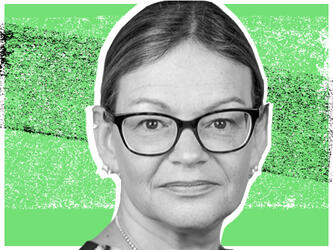Time for talking on diversity is up

Sapio’s Jess Bunce wrote an outstandingly researched piece on the status quo in MR when it comes to diversity. She pulled together data that tells a stark and unpalatable tale of just how far MR lags when it comes gender parity. You can count the number of female CEOs in the top 30 agencies on less than one hand, but what are we, as a discipline, doing about it? What initiatives can we introduce right now, so that tomorrow’s talent can see today that steps towards parity across the board are being taken in MR?
From where I’m sitting, MR as a discipline needs to act now, and act at all levels.
Act at grassroots
An effective starting point is invariably within our own businesses. Barriers to gender parity are well-documented – managing childcare and the drawbacks of part-time working stall career development as much as anything else.
Childcare costs often mean it simply isn’t financially viable for both partners to continue working full-time. Connect this with the fact that a disproportionate amount of part-time employees in this industry – and indeed across all verticals – are female, and you’d be forgiven for concluding it tends to be mums who take a career side-step. The rarity of part-time senior management fuels the belief that part-timers are often disproportionately overlooked for promotions (and pay rises).
It’s a perfect storm that we’re addressing at Future Thinking. We’re actively promoting more flexible working – including shared parental leave. SPL plays a crucial part in encouraging both parents to spend time with their kids and I can attest to the value of that from personal experience – I had four months when my second child was born, and my husband took a further five months off, which meant neither of us had to make the choice between career or child.
We’re also reviewing salary structures so that part-timers, regardless of gender, aren’t overlooked for promotion or pay simply because of an outdated notion that people need to be in the office five days a week to be effective. This includes focusing more on job sharing versus part-time working. The latter can sometimes hinder a company, whereas the former ensures nothing falls between the cracks on those days key employees are not working.
Embrace inclusion
Part and parcel of the steps we’re taking means we’re starting to reevaluate ingrained norms of what good working practices are. One of the fundamental things we’re learning at first hand is that this a shared enterprise – it’s not solely a female battle, it’s one that affects everyone.
In the words of Jayne-Anne Gadhia at the recent MRS conference, this is primarily about ‘equality, not feminism.’
Change will not come if men don’t lean in too. I applaud the MRS’ working group on inclusion and wholeheartedly believe it’s a step in the right direction. IPG’s Michael Roth pointed out at this year’s AdWeek Europe, ‘pale, male and stale’ isn’t cutting it with clients anymore. They’re seeking diversity to a depth that goes beyond box-ticking and quotas, to teams that are made up of the right men, women and yes, people of colour too. (Aviva and MRS president Jan Gooding, in the Conscious Marketing session at the MRS conference, went so far as to say she discounted all-male teams at RFI stage when she was in a marketing function.)
To quote IPG’s Roth, diversity and inclusion is now ‘a business imperative, particularly for the marketing communications business where our job is to connect clients with consumers. If we absolutely do not represent the consumer... We cannot meet the perception that we are adding value’.
In practical terms then, it’s essential to include men as well as women in events, groups and conversations around parity.
Emulate sister disciplines
No one’s perfect, not least when it comes to gender equality. But some disciplines are putting more of a focus on it than others. Advertising is one of the closest relations MR has, and we could do worse than look to emulate some of the initiatives adland has instigated on its diversity journey.
If we can partner with some of these initiatives – and I’d argue that it’s the role of bodies like the MRS to engage with their counterparts in other disciplines on behalf of their members – then so much the better. Playing a part in programmes such as as timeTo, the initiative set up by an alliance of NABS, the Advertising Association and WACL to combat sexual harassment in the workplace, champions the part women play in business.
Until then, I’d call on groups like Women in Research to work on industry-wide mentorship schemes – after all, you’ve got to see it to be it. And creating MR’s own version of initiatives like Jolt (a new initiative in advertising aiming to drive diversity in creative agencies) looks like an effective way to mine a rich talent pool that is diverse in all senses.
My suggestions are starters for 10, a call to action – because doing nothing is not an option.
Adele Gritten is UK MD of Future Thinking.

We hope you enjoyed this article.
Research Live is published by MRS.
The Market Research Society (MRS) exists to promote and protect the research sector, showcasing how research delivers impact for businesses and government.
Members of MRS enjoy many benefits including tailoured policy guidance, discounts on training and conferences, and access to member-only content.
For example, there's an archive of winning case studies from over a decade of MRS Awards.
Find out more about the benefits of joining MRS here.













3 Comments
Annie Pettit
7 years ago
Hear hear. I've been keeping track of gender ratios of speakers at conferences for several years. What I've learned is that we're great at talking about diversity but when it comes right down it, we're less than great at converting that talk into action. Thus far in 2018, only 3 conferences out of 18 generated speaker parity - NewMR, The ARF, and the AMRA in *Africa*. I applaud those organizations for walking the talk. If we truly care about diversity, we must go out of our way to MAKE IT HAPPEN. Don't wait for women, people of colour, people with disabilities, or any underrepresented people to raise their hand. Nudge like you've never nudged before. Encourage, entice, goad, coax, cajole them. It is everyone's responsibility to create the change we want to see. You can see how conferences are doing so far this year in one of my blog posts. Feel free to send me data from any conferences I've missed. https://lovestats.wordpress.com/2018/01/24/2018-market-research-conference-speaker-gender-tracker-mrx-newmr/ Don't get mad. Take action. Annie
Like Reply Report
Annie Pettit
7 years ago
By the way, I just updated the tracker with more conferences. https://lovestats.wordpress.com/2018/01/24/2018-market-research-conference-speaker-gender-tracker-mrx-newmr/
Like Reply Report
Women in Research (WIRe)
7 years ago
Thanks for this article Adele and Research Live! You’ve made so many salient points that we agree with you on; from top to bottom, there are unfair obstacles on the journey to the boardroom for many—not just women. At the end of your article you call for our organization (Women in Research) to work on an industry-wide mentorship program. We whole-heartedly agree that “you’ve got to see it to be it” and have been offering one-on-one and virtual mentoring (https://www.womeninresearch.org/mentoring/) for a few years now. On that same note, our Office Hours forum (https://www.womeninresearch.org/office-hours/) is a way for those without access to the mentorship opportunities we provide to interact with industry experts on a variety of topics. Further, our 50/50 Conference Initiative (https://www.womeninresearch.org/5050-initiative/) aims to combat the very same issues of misrepresentation at industry conferences that you describe in your article. WIRe’s Global Scholarship Fund is a community-sourced scholarship opportunity for a female-student in an economically-challanged market entering into a market research-related field. We’ve funded a student in Cambodia as well as Kenya and are actively funding another student, this time in Guatemala. As a call-to-action, we invite all who are seeking a way to directly impact the landscape of mrx to support this campaign (https://www.womeninresearch.org/wire-scholarship/). We’d also like to invite all who are interested in collaborating with Women in Research (https://www.womeninresearch.org) on any of the programs I’ve mentioned, or the issues raised in the above article, to reach out to Jessica Sage at jessica@womeninresearch.org. With many hands and minds working together, we can keep the momentum of progress and change going!
Like Reply Report